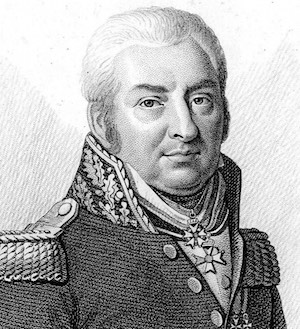General Nicolas-Antoine Sanson

Born: December 7, 1756
Place of Birth: Paris, Paris, France
Died: October 29, 1824
Place of Death: Paris, France
Arc de Triomphe: SANSON on the south pillar
Pronunciation:
Volunteering to join the army during the Revolution, Nicolas-Antoine Sanson volunteered as part of the 1st Battalion of Tarn in March of 1792. He initially served with the Army of the Interior before being sent to the Army of the Eastern Pyrenees. In September of 1793 Sanson was promoted to capitaine of engineers by the representatives of the people with the army. Later that year he was wounded by a saber blow to the left hand while on a reconnaissance. In August of 1794 Sanson served at the combat of Saint-Laurent de la Mouga where he was again wounded, this time in the right thigh. Nevertheless, the next month he was in action again at Bellegarde, and then later he served at the sieges of Figuières and Roses. Sanson received a promotion to chef de bataillon in February of 1795 and he was then named chief engineer of Bellegarde.
After peace was signed with Spain, Sanson was sent to the Army of Italy in April of 1796. He served at the action of Pavia, the siege of Milan, and the camp of Migliaretto. That July Sanson served at the Siege of Mantua and he fortified the post of Saint-Georges. The next month he fought at the Battle of Castiglione where he was wounded by a shot to the hip. In September Sanson served at Trente, Bassano , Legnano, and Saint-Georges. The next year he served at Caldiero and the Battle of Rivoli in January before he was named director of fortifications at Mantua in February. A promotion to chef de brigade followed later in February.
Sanson was designated for the Army of England and then the Army of the Orient in 1798. Serving under General Andreossy, he took part in the action of Malta and then the action of Alexandria. In July of 1798 Sanson fought at Chebreiss and then at the Battle of the Pyramids . That December he built a fort at Katieh. Sanson took part in the expedition to Syria in 1799 and he served at the sieges of El Arisch, Jaffa, and Acre. At Acre he was wounded in the hand by a ball. After General Caffarelli died, General Bonaparte named Sanson commander-in-chief of the engineers of the army and then four months later in August Bonaparte promoted Sanson to général de brigade. Sanson remained with the Army of the Orient and he served at Héliopolis and the siege of Cairo in 1800. In 1801 he commanded the engineers for the defense of Alexandria until the French finally surrendered to the British. During this time Sanson refused a promotion to général de division.
After returning to France in late 1801, in 1802 General Sanson received a saber of honor and he was named director of the general depot of war. In 1805 he was named a Commander of the Legion of Honor and he was sent on a mission to Brest. When the Grande Armée moved east to do battle with the Third Coalition in 1805, Sanson joined the staff of the army as the third major aide of the topographic service. During that campaign he served at Ulm and the Battle of Austerlitz. When the Prussians declared war in 1806 and Napoleon responded, Sanson served at the Battle of Jena in October of 1806. In 1807 he served at the Battle of Eylau in February and then in June he served at Guttstadt, Heilsberg, and Friedland. Afterwards he was promoted to général de division and then in 1808 he was named a Count of the Empire.
Sanson was sent to Spain to command the engineers of V Corps and in 1808 he took part in the Siege of Roses and the Siege of Gerona. In 1809 he was named inspector of engineers of the general depot of war and he left Spain to fulfill this post. Sanson also received the honor of being named a Commander of the Order of Maximilian Joseph of Bavaria. In 1812 Sanson joined the army to serve as a director of the topographic service while on campaign in Russia. He served throughout the campaign into Russia but he was taken prisoner during the retreat. Sanson was only finally released and allowed to return to France after Napoleon's abdication in 1814. The restored Bourbons named him a Knight of Saint Louis, and then when Napoleon resumed power in 1815 for the Hundred Days, Sanson served as inspector general of fortifications. Later that year he retired from the army.
Bibliography
Updated December 2016
© Nathan D. Jensen